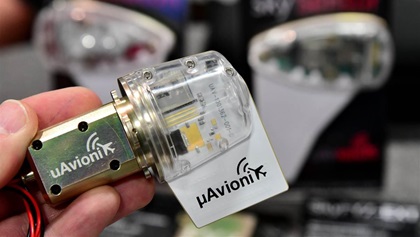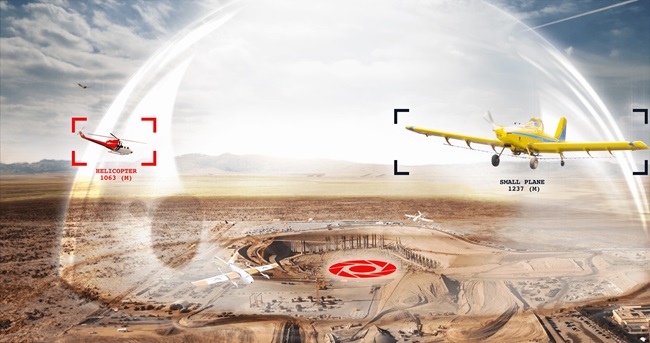ADS-B: FAA approves uAvionix wingtip ADS-B
Innovative design offers easy installation

Many pilots have expressed interest in skyBeacon because of its simple installation. Designed to replace a standard wingtip position light, the company said that for many, aircraft installation will require removing three screws, connecting three wires, and replacing the screws. It uses the existing wiring and circuit breaker; no airframe modifications or additional antennas are required. The miniature universal access transceiver provides ADS-B Out on 978 MHz, and uAvionix says it will work with any Mode C or Mode S transponder.
ADS-B uses satellites instead of ground-based radar to determine aircraft position, and it is a key technology behind the FAA’s Next Generation Air Transportation System. The FAA has mandated ADS-B Out equipage for flights after January 1, 2020, in airspace where a transponder is required today.
“skyBeacon has already become popular in the Experimental and Light Sport aircraft categories, and is expected to be hugely popular in the certified aircraft market, too,” said Ryan Braun, uAvionix chief operating officer and the product’s certification lead. “Its speedy plug-and-play installation provides the lowest total installed cost of ownership ADS-B Out solution on the market.”
The addition of an altimeter—necessitating the fifth TSO—late in the certification process delayed the company’s original certification timeline, Braun explained. “The additional component makes the skyBeacon able to address a larger range of aircraft, specifically those with an existing Mode S transponder,” he said, and it allows skyBeacon to provide pressure altitude to surrounding traffic and ATC regardless of radar coverage.
Braun said skyBeacon’s unique form factor forced the company to innovate new solutions. “This was especially true for the WAAS GPS, where no existing receiver could meet our size, cost, and performance needs. This meant both designing our own GPS, and working with the FAA to develop a new process for certification of complex COTS [commercial off-the-shelf] solutions. This will change the way avionics are developed and certified in the future, increasing technology and lowering cost.”
This will change the way avionics are developed and certified in the future, increasing technology and lowering cost.“This was a magnificent effort by our entire team,” said Paul Beard, chief executive officer. “I have never seen a more dedicated, sustained, and high-intensity effort. The patience and guidance of the Chicago ACO and FAA headquarters staff, and feedback from our customers, has kept us pressing forward. Not only has a special product been created, but a roadmap for bringing similarly innovative and cost-effective technology to aircraft has been drawn.”
AOPA learned in August that Garmin International filed a lawsuit against uAvionix in June, claiming that uAvionix is infringing on a Garmin patent with technology in the skyBeacon and other ADS-B hardware. uAvionix disputes the allegation and said in a statement that the suit will not affect its delivery of ADS-B products.
uAvionix anticipated supplemental type certificate (STC) approval by October for multiple Cessna and Piper aircraft. A March 2016 FAA policy memorandum and a September 2017 FAA tech paper, “Installation of ADS-B Out Equipment,” explain how a previously approved STC can be used to approve a follow-on installation of certified ADS-B hardware. After that initial STC, uAvionix said, subsequent skyBeacon installations can be performed on any “suitable aircraft”—any aircraft that does not require airframe modification—as a minor alteration, without an additional or airframe-specific STC.
The company also said it would move forward immediately with TSO certification of its tailBeacon product, very similar to the wingtip-mount skyBeacon but intended for installation on the tail of aircraft where the wingtip mount is not practical—because of wingtip light design or aftermarket wing tips, for example.
The company has been using microavionics employing commercial off the shelf (COTS) technology and adapting them for aviation. “It’s been a really interesting road,” Braun said. “The FAA has a new policy around this. The hope is that it will roll out to the whole industry, but we’re pioneering it.” He said an example is taking millimeter-wave radar from self-driving cars and using it in drones.
“We’ve got some really neat technology going on here. This has not been an easy project to certify.” And the company decided to certify the skyBeacon to existing standards, he said, rather than pursue alternative paths to certification.
Braun said the company has had a good relationship with the FAA, which has been very collaborative through the certification process. “Everybody’s working together to wind through policies that were written 50 years ago. We couldn’t be more proud and excited to have this out there.”
The idea was first announced at EAA AirVenture 2017. “It was still a bit of a crazy idea at the time. We really hoped to have this out by Sun ’n Fun—welcome to the cert world,” Braun laughed. “But we’re doing things that haven’t been done before.” He said the company spent six months working with the FAA on how it could possibly work the product through certification, and “six months of mad engineering. It’s not like any of the other boxes.”
And the product has evolved along the way. In addition to adding an altimeter, the company decided to make the LED strobe standard when it certified skyBeacon, so it would not have to make and inventory two versions. Similarly, with TSO authorizations in hand, Braun said the non-TSOed Experimental version will be phased out; both are priced at $1,849. The company plans to offer a matching green LED position light and strobe for the right wing.
How long will the installation take? uAvionix estimates about one hour—maybe 20 minutes for the physical installation, plus time to complete the required paperwork. An airframe and powerplant mechanic can install it on a certified aircraft; the work should be signed off by an A&P with inspection authorization. For more information, see the website.
Email [email protected]




